Punjab State Board PSEB 8th Class Maths Book Solutions Chapter 3 Understanding Quadrilaterals Ex 3.3 Textbook Exercise Questions and Answers.
PSEB Solutions for Class 8 Maths Chapter 3 Understanding Quadrilaterals Ex 3.3
Question 1.
Given a parallelogram ABCD. Complete each statement along with the definition or property used:

(i) AD = ……………
(ii) ∠DCB = ……………
(iii) OC = ……………
(iv) m∠DAB + m∠CDA = ……………
Solution:
(i) AD = BC
(∵ Opposite sides are equal)
(ii) ∠DCB = ∠DAB
(∵ Opposite angles are equal)
(iii) OC = OA
(∵ Diagonals bisect each other)
(iv) m∠DAB + m∠CDA = 180°
(∵ Adjacent angles are supplementary)
![]()
Question 2.
Consider the following parallelograms. Find the values of the unknowns x, y, z.
(i)
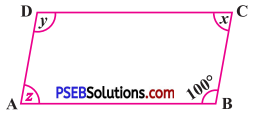
Solution:
□ ABCD is a parallelogram.
∴ ZB = ZD
∴ y = 100°
(∵ Opposite angles)
Now, y + z = 180° (∵ Adjacent singles are supplementary)
∴ 100° + z = 180°
∴ z = 180° – 100°
∴ z = 80°
Now, x = z (∵ Opposite angles)
∴ x = 80°
Thus, x = 80°, y = 100° and z = 80°.
(ii)

Solution:
It is a parallelogram.
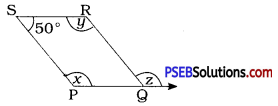
∴ m∠P + m∠S = 180°
(∵ Adjacent angles are supplementary)
∴ x + 50° = 180°
∴ x = 180° – 50°
∴ x = 130°
x = y (∵ Opposite angles)
∴ y = 130°
Now, m∠Q = 50° (∵ ∠S and ∠Q are opposite angles)
m∠Q + z = 180° (∵ Linear pair of angles)
∴ 50° + z = 180°
∴ z = 180° – 50°
∴ z = 130°
Thus, x = 130°, y = 130° and z = 130°.
(iii)
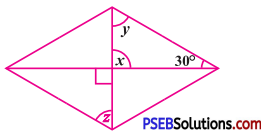
Solution:
Vertically opposite angles are equal.
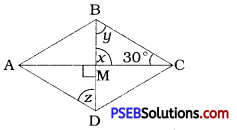
∴ m∠AMD = m∠BMC = 90°
∴ x = 90°
In ΔBMC
y + 90° + 30° = 180°
(Angle sum property of a triangle)
∴ y + 120° = 180°
∴ y = 180° – 120° = 60°
Here, ABCD is a parallelogram
∴ \(\overline{\mathrm{AD}} \| \overline{\mathrm{BC}}, \overline{\mathrm{BD}}\) is a transversal.
∴ y = z (∵ Alternate angles)
∴ z = 60° (∵ y = 60°)
Thus, x = 90°, y = 60° and z = 60°
(iv)
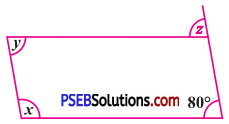
Solution:
□ ABCD is a Dparallelogram.
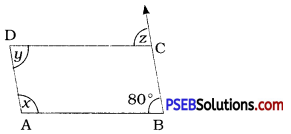
∠D = ∠B (∵ Opposite angles)
∴ y = 80°
m∠A + m∠D = 180° (∵ Adjacent angles are supplementary.)
∴ x + y = 180°
∴ x + 80° = 180°
∴ x = 180° – 80°
∴ x = 100°
m∠A = m∠BCD (∵ Opposite angles are equal)
∴ 100° = m∠BCD
Now, z + m∠BCD = 180° (∵ Linear pair of angles)
∴ z + 100° = 180°
∴ z = 180° – 100°
∴ z = 80°
Thus, x = 100°, y = 80° and z = 80°
(v)
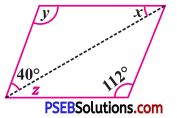
Solution:
□ ABCD is a parallelogram.
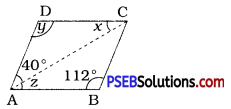
∴ m∠B = m∠D (∵ Opposite angles)
∴ y = 112°
m∠A + m∠B = 180°
(∵ Adjacent angles are supplementary)
∴ (40° + z) + 112° = 180°
∴ 40° + z + 112° = 180°
∴ z + 152° = 180°
∴ z = 180° – 152°
∴ z = 28°
Now, \(\overline{\mathrm{DC}} \| \overline{\mathrm{AB}}\), \(\overleftrightarrow{\mathrm{AC}}\) is their transversal.
∴ z = x
∴ x = 28° (∵ z = 28°)
Thus, x = 28°, y = 112° and z = 28°
![]()
Question 3.
Can a quadrilateral ABCD be a parallelogram if
(i) ∠D + ∠B = 180°?
Solution:
In a quadrilateral ABCD,
∠D + ∠B = 180° (Given)
In parallelogram, the sum of measures of adjacent angles is 180°.
But here, the sum of measures of opposite angles is 180°.
∴ The quadrilateral may be a parallelogram.
(ii) AB = DC = 8 cm, AD = 4 cm and BC = 4.4 cm?
Solution:
In a quadrilateral ABDC,
AB = DC = 8 cm
AD = 4 cm
BC = 4.4 cm
∵ Opposite sides AD and BC are not equal.
∴ It cannot be a parallelogram.
(iii) ∠A = 70° and ∠C = 65° ?
Solution:
In a quadrilateral ABCD, m∠A = 70° and m∠C = 65°
Opposite angles ∠A ≠ ∠C
∴ It cannot be a parallelogram.
Question 4.
Draw a rough figure of a quadrilateral that is not a parallelogram but has exactly two opposite angles of equal measure.
Solution:

Here, ∠B = ∠D (see figure)
Yet, it is not a parallelogram.
![]()
Question 5.
The measures of two adjacent angles of a parallelogram are in the ratio 3 : 2. Find the measure of each of the angles of the parallelogram.
Solution:
Let ABCD be a parallelogram in which adjacent angles ∠A and ∠B are 3x and 2x respectively.
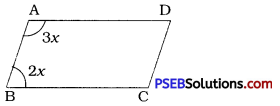
Adjacent angles are supplementary.
∴ m∠A + m∠B = 180°
∴ 3x + 2x – 180°
∴ 5x = 180°
∴ \(\frac{180^{\circ}}{5}\)
∴ m∠A = 3x = 3 × 36° = 108°
m∠B = 2x = 2 × 36° = 72°
Now, m∠A = m∠C and m∠B = m∠D (∵ Opposite angles)
∴ m∠C = 108° and m∠D = 72°
Thus, ∠A = 108°, ∠B = 72°, ∠C = 108° and ∠D = 72°.
Question 6.
Two adjacent angles of a parallelogram have equal measure. Find the measure of each of the angles of the parallelogram.
Solution:
Let ABCD be a parallelogram such that adjacent angles ∠A = ∠B.
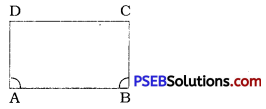
∴ m∠A + m∠B = 180°
(∵ Adjacent angles are supplementary)
∴ m∠A + m∠A = 180° (m∠B = m∠A)
∴ 2m∠A = 180°
∴ m∠A = \(\frac{180^{\circ}}{2}\) = 90°
∴ m∠B = 90°
Now, m∠A = m∠C and m∠B = m∠D (∵ Opposite angles)
∴ m∠C = 90° and m∠D = 90°
Thus, ∠A = 90°, ∠B = 90°, ∠C = 90° and ∠D = 90°.
![]()
Question 7.
The adjacent figure HOPE is a parallelogram. Find the angle measures x, y and z. State the properties you use to find them.
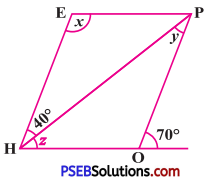
Solution:
∠POA is the exterior angle of ΔHOE
∴ y + z = 70° (Exterior)
∴ m∠HOP = 180° – 70° = 110°
∠HEP = ∠HOP = 110° (Opposite angles of a parallelogram)
∴ x = 110°
∵ \(\overline{\mathrm{EH}} \| \overline{\mathrm{PO}}\), \(\overleftrightarrow{\mathrm{PH}}\) is a transversal.
∴ y = 40° (∵ Alternate angles are equal)
Now, y + z = 70°
∴ 40° + z = 70°
∴ z = 70° – 40° = 30°
Thus, x = 110°, y = 40° and z = 30°
Question 8.
The following figures GUNS and RUNS are parallelograms. Find x and y. (Lengths are in cm)
(i)
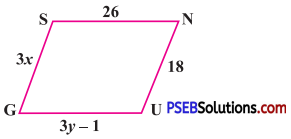
Solution :
□ GUNS is a parallelogram.
∴ GS = NU and SN = GU (Y Opposite sides)
∴ 3x = 18 and 26 = 3y – 1
∴ x = \(\frac {18}{3}\)
∴ x = 6
∴ 3y – 1 = 26
∴ 3y = 26 + 1
∴ 3y = 27
∴ y = \(\frac {27}{3}\) = 9
Thus, x = 6 cm and y = 9 cm
(ii)

Solution:
□ RUNS is a parallelogram.
∴ Its diagonals bisect each other.
x + y = 16 ……(1)
and y + 7 = 20
y = 20 – 7 = 13 …..(2)
Substituting value of y in (1)
x + y = 16
x + 13 = 16
∴ x = 16 – 13
= 3
Thus, x = 3 cm and y = 13 cm
![]()
Question 9.

In the above figure both RISK and CLUE are parallelograms. Find the value of x.
Solution:
□ RISK is a parallelogram.
∴ m∠R + m∠K = 180°
(∵ Adjacent angles are supplementary)
∴ m∠R + 120° = 180°
∴ m∠R = 180° – 120°
∴ m∠R = 60°
∠R and ∠S are opposite angles of parallelogram.
∴ m∠S = 60°
□ CLUE is a parallelogram.
∴ m∠E = m∠L = 70° (∵ Opposite angles)
In ΔESQ
∴ m∠E + m∠S + x = 180° (∵ Angle sum property of triangle)
∴ 70° + 60° + x = 180°
∴ 130° + x = 180°
∴ x = 180° – 130°
∴ x = 50°
Thus, x = 50°
Question 10.
Explain how this figure is a trapezium. Which of its two sides are parallel ? (Fig3.32)

Solution:
Since, 100° + 80° = 180°
i. e., ∠M and ∠L are supplementary.
∴ \(\overline{\mathrm{NM}} \| \overline{\mathrm{KL}}\)
(∵ Interior angles along on the same side of the transversal are supplementary)
One pair of opposite side of □ LMNK is parallel.
∴ □ LMNK is a trapezium.
![]()
Question 11.
Find m∠C in figure 3.33 if \(\overline{\mathbf{A B}} \| \overline{\mathbf{D C}}\).
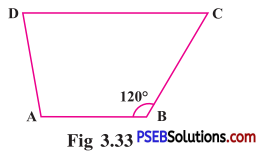
Solution:
In □ ABCD, \(\overline{\mathrm{AB}} \| \overline{\mathrm{DC}}\) and BC is their transversal,
∴ m∠B + m∠C = 180°
(∵ Interior angles on the same side of transversal are supplementary)
∴ 120° + m∠C = 180°
∴ m∠C = 180° – 120° = 60°
Thus, m∠C = 60°
Question 12.
Find the measure of ∠P and ∠S if \(\overline{\mathrm{SP}} \| \overline{\mathrm{RQ}}\) in figure 3.34. (If you find m∠R, is there more than one method to find m∠P ?)

Solution:
In □ PQRS \(\overline{\mathrm{SP}} \| \overline{\mathrm{RQ}}\)
∴ □ PQRS is a trapezium.
\(\overleftrightarrow{\mathrm{PQ}}\) is a transversal of \(\overline{\mathrm{SP}} \| \overline{\mathrm{RQ}}\)
m∠P + m∠Q = 180°
(∵ Interior angles on the same side of transversal are supplementary)
∴ mZP + 130° = 180°
∴ mZP = 180° – 130°
∴ mZP = 50°
In □ PQRS, ∠R = 90°
\(\overline{\mathrm{SP}} \| \overline{\mathrm{RQ}}\), \(\overleftrightarrow{\mathrm{RS}}\) is their transversal.
∴ m∠S + m∠R = 180°
∴ m∠S + 90° = 180°
∴ m∠S= 180°-90°
∴ m∠S = 90°
Yes, the sum of the measures of all angles of quadrilateral is 360°. ∠P and ∠R can be found.
m∠P + m∠Q + m∠R + m∠S = 360°
∴ m∠P + 130° + 90° + 90° = 360°
∴ m∠P + 310° = 360°
∴ m∠P = 360° – 310°
∴ m∠P = 50°